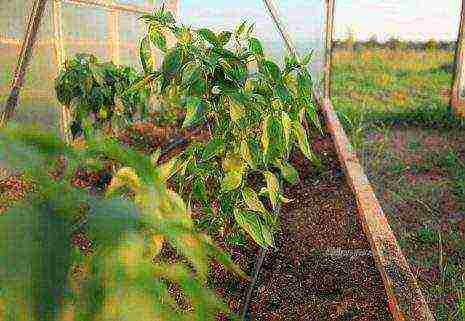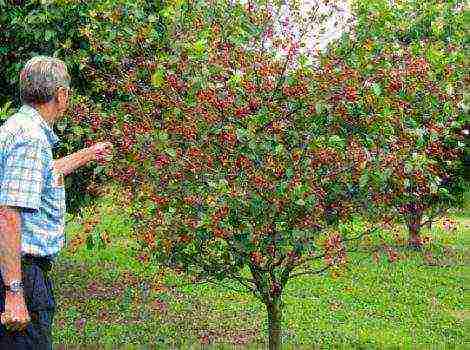Content
- 1 Description of the most popular varieties for the Moscow region and central Russia
- 2 The best large-fruited gooseberry varieties
- 3 The best winter-hardy gooseberry varieties
- 4 The best studless gooseberry varieties
- 4.1 Eaglet
- 4.2 African
- 4.3 Northern captain
- 4.4 Ural besshorny
- 4.5 Thornless gooseberry
- 4.5.0.1 Description of the variety "Grushenka"
- 4.5.0.2 Description of the variety "Malachite"
- 4.5.0.3 Description of the variety "Commander"
- 4.5.0.4 Description of the variety "Kolobok"
- 4.5.0.5 Description of the variety "Krasnoslavyansky"
- 4.5.0.6 Description of the variety "Amber"
- 4.5.0.7 Description of the variety "Honey"
- 4.5.0.8 Description of the variety "Lada"
- 4.5.0.9 Description of the variety "Beryl"
- 4.5.0.10 Description of the variety "Canned"
- 4.5.0.11 Description of the "Consul" variety
- 4.5.0.12 Description of the variety "Invicta"
- 4.5.0.13 Description of the variety "Russian Yellow"
- 4.5.0.14 Description of the variety "Emerald"
- 4.5.0.15 Description of the variety "Date"
- 4.5.0.16 Description of the variety "Bogatyr"
- 4.5.0.17 Description of the "Redball" variety
- 4.5.0.18 Description of the variety "Plum"
- 4.5.0.19 Description of the variety "Grossular"
- 4.5.0.20 Description of the variety "Belarusian red"
- 4.5.0.21 Description of the variety "Green Rain"
- 5 What to consider when choosing a gooseberry variety?
- 6 Interesting photos of gooseberry varieties with a description
- 7 Popular gooseberry varieties without thorns
- 8 Features of growing gooseberries in the Urals
- 9 Key findings
Gooseberries can be found in almost every site in the central region of Russia. Gardeners often think about which variety to choose and plant. Let's try to figure it out together by reading the description of the most popular ones. Varieties are divided according to many criteria, Kolobok, Grushenka, Russian yellow and Amber are most suitable for the Moscow region... The most frost-resistant are Beryl, Ural emerald, Consul and others. The largest fruits are produced by the varieties Zashchitnik, Kooperator, Leningradets and others. They have excellent taste - Medovy, Kaptivator, Pushkin, Sadko, Laskovy, English, Mashenka and others. Thornless gooseberries are the safest, besides, it is easier to care for them, the best and most popular varieties are Eaglet, African, Thornless gooseberry and others.
Description of the most popular varieties for the Moscow region and central Russia
Grushenka
 Gooseberry variety Grushenka
Gooseberry variety Grushenka
Medium-sized shrub with drooping branches. There are practically no thorns on the shoots. The berries are medium-sized, weigh on average 5 grams, the shape is pear-shaped, and the color changes as the fruits ripen (from pale red to deep purple). The variety is perfect for growing in central Russia, it is able to easily endure frosts, winter cold and drought. It is immune to many diseases.
Russian yellow
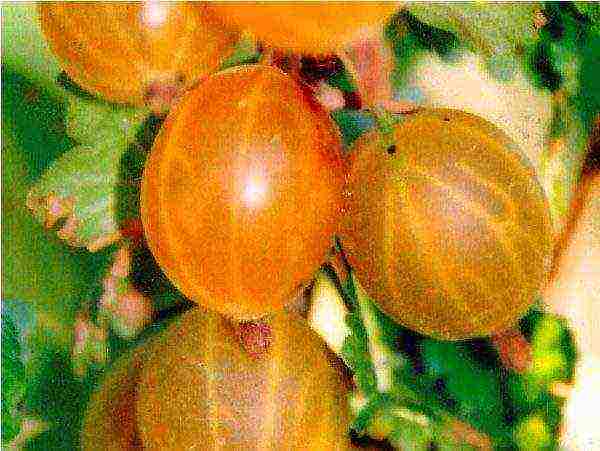 Gooseberry variety Russian yellow
Gooseberry variety Russian yellow
A low bush with medium spreading, covered with thorns throughout the area. Produces yellow pear-shaped fruits weighing up to 6 grams... The presence of a thin waxy coating is characteristic. The variety is distinguished by its excellent tolerance to sudden changes in temperature, frost and drought. Self-fertile, not affected by many common diseases.
Amber
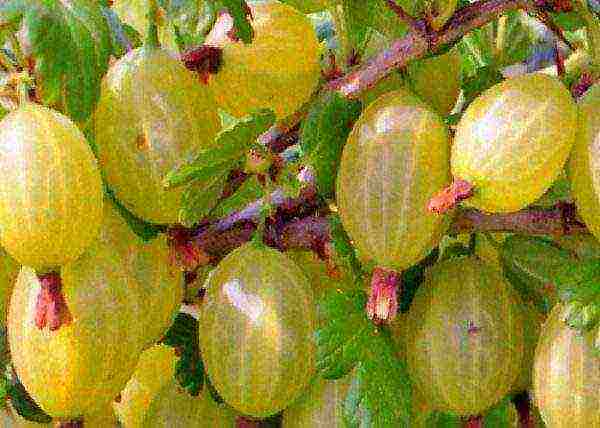 Gooseberry grade Amber
Gooseberry grade Amber
A tall shrub can grow up to 1.5 meters. The crown is dense and spreading, and there are also many thorny thorns on it. But all these disadvantages are offset by delicious and beautiful fruits. Berries are yellow-orange in color and oblong in shape, on average, weigh 5-6 grams... Amber gooseberries are early varieties and have a very high yield. Also, this shrub tolerates frost and drought well.
Gingerbread man
 Gooseberry variety Kolobok
Gooseberry variety Kolobok
A medium-sized shrub with thorns, which are located singly, most often on the lower part of the branches. Fruits are large in size, their weight reaches 7 grams... The shape of the berries is slightly elongated, the color is pale red. The taste is pleasant, sweet and sour.The variety tolerates frost well, is resistant to anthracnose and powdery mildew.
The best large-fruited gooseberry varieties
Defender
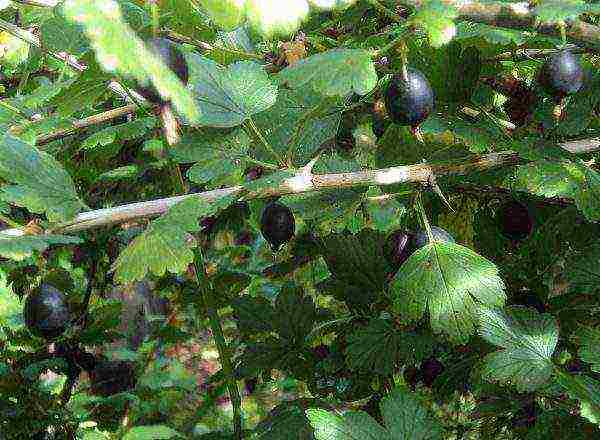 Gooseberry variety Defender
Gooseberry variety Defender
A tall shrub with powerful branches and a straight crown. The mass of berries can reach 10 grams, their shape is oval-pear-shaped, the color is burgundy, almost black... The taste of the fruit is sweet and sour. Refers to varieties with a late ripening period. The defender tolerates frost well, does not undergo powdery mildew.
Cooperator
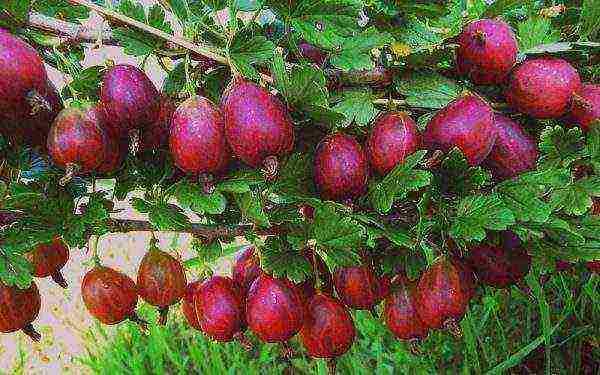 Gooseberry variety Cooperator
Gooseberry variety Cooperator
This type of shrub has a medium height and a sparse, slightly spreading crown with a small number of thorns. On average, one berry weighs 7 grams, pear-shaped, dark red color... Such fruits are considered dessert, they are very tasty and sweet. Up to 5 kilograms of harvest can be harvested from one bush, the ripening period is medium late. Another advantage of the variety is its resistance to cold weather and fruit rot.
Leningrader
 Gooseberry grade Leningradets
Gooseberry grade Leningradets
A bush of medium height with a semi-spreading crown, thorns are practically absent. The berries are large, their weight can reach 10 grams, the shape resembles an inverted egg, the color is dark red... Gooseberry taste sweet and sour. From one bush, you can collect up to 7.5 kilograms of harvest, medium late ripening. The shrub is winter-hardy, moderately exposed to powdery mildew.
Spring
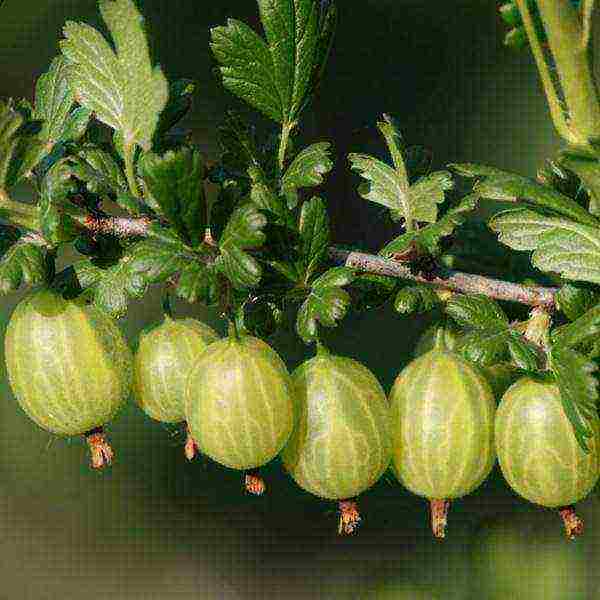 Gooseberry variety Rodnik
Gooseberry variety Rodnik
Shrub of medium height with a compact, neat crown. On average, the fruits weigh 5-6 grams, but their weight can reach 8 grams, the shape is round-oval, the color is dull, yellow-green... The taste of such berries is very pleasant, sweet, they are suitable both for fresh consumption and for any kind of processing. The variety is resistant to frost and fungal diseases, it is distinguished by its ability to reproduce crops even under unfavorable climatic conditions.
The best winter-hardy gooseberry varieties
Beryl
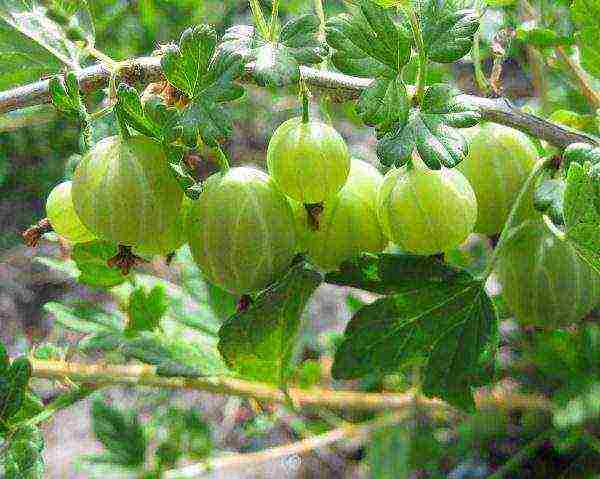 Gooseberry grade Beryl
Gooseberry grade Beryl
Medium-sized shrub with a neat crown. Thorns are present at the bottom of the shoot. The weight of berries can reach 8-9 grams, the shape is spherical, the color is light green... The taste of the fruit is dessert, highly appreciated by professional tasters. One bush brings up to 9 kilograms of harvest and can survive frost down to -36 degrees. Also, the variety is resistant to fruit rot.
Ural emerald
 Gooseberry grade Ural emerald
Gooseberry grade Ural emerald
Medium-sized shrub with few thorns on the shoots. Berries are distinguished by the absence of pubescence, their weight can reach 8 grams... This variety got its name due to the bright color of the fruit with a dessert taste and pleasant aroma. The first harvest can be obtained at 3-4 years of life, the ripening period is medium early. Frost resistance is high, such a shrub can withstand cold temperatures down to -37 degrees.
Consul
 Gooseberry grade Consul
Gooseberry grade Consul
Another name for this variety is senator. A medium-sized bush with a dense crown, on which thorns are practically absent. The berries are large, their weight can reach 6 grams, the color is maroon, almost black... The skin of the fruit is very thin, so they do not tolerate transportation well. Also, such berries have very few seeds, which makes them an excellent jam. The shrub tolerates frosts well down to -37 degrees. In the first years of his life, the Senator gives little harvest, but over time this figure increases 2-3 times.
Belorussian
 Gooseberry grade Belarusian
Gooseberry grade Belarusian
A small bush with a compact crown, on which there are a lot of sharp thorns. Ball-shaped berries weigh no more than 8 grams... The color is bright green. The taste is very pleasant, sweet, the skin of the fruit is thin, and the pulp is juicy and tender. The variety belongs to the old selection, has a very high frost resistance (up to -39 degrees). The harvest ripens in medium terms.
Krasnoslavyansky
 Gooseberry grade Krasnoslavyansky
Gooseberry grade Krasnoslavyansky
The bush is of medium height, slightly spreading, the crown is sparse, there are thorns on the shoots. The berries are large enough, the maximum weight can reach 9 grams, the shape is round, the color is deep red... There is practically no pubescence on the skin. The taste of such gooseberries is considered dessert. The first crop can be harvested already in the second year of the plant's life, but over time this figure becomes larger and reaches 6-7 kilograms. Also, the variety is very frost-resistant, resistant to powdery mildew.
The best studless gooseberry varieties
Eaglet
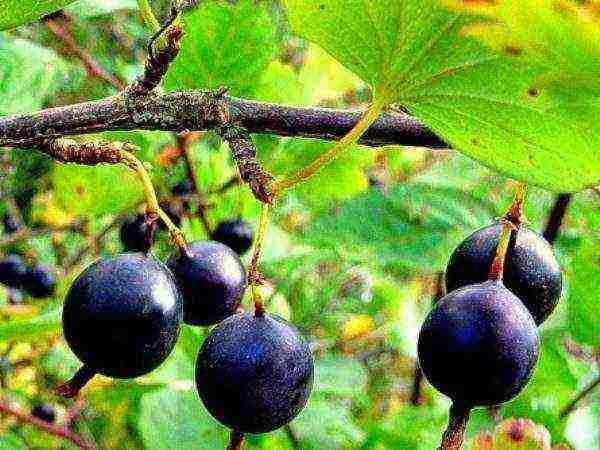 Gooseberry grade Eaglet
Gooseberry grade Eaglet
A medium-sized shrub with a neat and small crown. The lack of thorns makes this variety one of the most popular among gardeners. On average, one berry weighs 4-6 grams, the color is almost black... Differs in the presence of a light military raid and a pleasant sweet and sour taste. The crop ripens early, the shrub bears fruit annually and abundantly, it is resistant to frost and fruit rot.
African
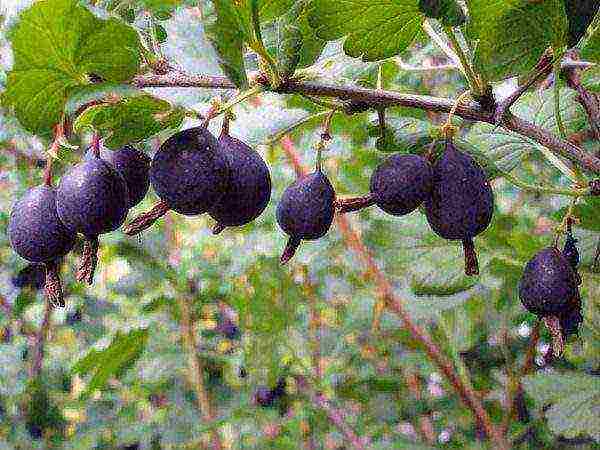 Gooseberry variety African
Gooseberry variety African
A medium-sized bush with no thorns. The berries are not large, rounded, dark purple in color... The taste of the fruit is sweet and sour, with light notes of black currant. The shrub begins to bear fruit in 2-3 years after planting, has good winter hardiness and resistance to many diseases. There is a risk of contracting anthracnose.
Northern captain
 Gooseberry variety Northern Captain
Gooseberry variety Northern Captain
One of the most popular gooseberry varieties. A tall shrub with a narrow, neat crown, the branches of which grow straight up. Berries are dark, almost black in color, their weight can reach 4 grams... The taste of the fruit is pleasant, with a slight sourness. The ripening period of the crop is average. With proper care, up to 12 kilograms of fruit can be removed from one shrub... Among other things, the North Captain tolerates frost, drought and is not exposed to many diseases.
Ural besshorny
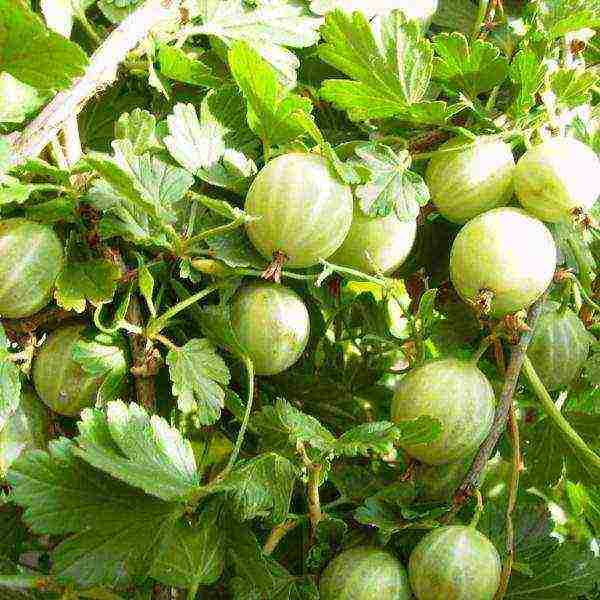 Gooseberry grade Ural Besshipny
Gooseberry grade Ural Besshipny
Medium-sized shrub that bears bright green, large (up to 8 grams) oval fruits... The variety is medium late, there is no pubescence on the skin, the fruit pulp is sweet and pleasant to the taste. The variety tolerates frost well, but may begin to drop berries ahead of time, which will lead to a loss of yield. Gooseberries are recommended to be picked a little earlier than they are fully ripe. In addition, the absence of thorns will make this process even easier and more enjoyable.
Thornless gooseberry
 Thornless gooseberry
Thornless gooseberry
The bush is vigorous, but at the same time its crown is very compact, and the branches grow mainly upward. On average, the berries weigh 5 grams, have a drop-like shape and a light red color.... The taste of the fruit is pleasant, sweet with a barely noticeable sourness. The variety tolerates winter cold well and is not subject to powdery mildew.
Both adults and children love gooseberries. A resident of any region will be able to choose a variety that is suitable for himself, you can also pick berries according to taste, size and other indicators... The modern market offers a huge variety of different varieties of gooseberries.
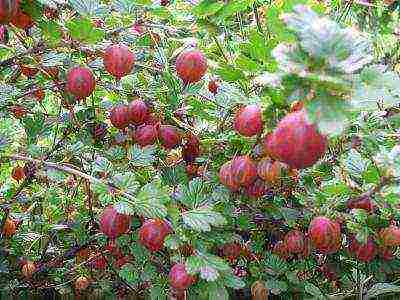 The history of gooseberry cultivation in Russia goes back almost ten centuries. During this time, he managed to fall in love with his bright taste and benefits - after all, jam and jams, compotes and wines are made from the fruits of this plant. During its long history, gooseberries have acquired a lot of varieties. The cultivation of varieties was undertaken especially intensively in the 1960s and 80s, and during this time they achieved considerable success. If you want to harvest an excellent and stable harvest, then you need to understand all the variety of varieties and choose the best one.
The history of gooseberry cultivation in Russia goes back almost ten centuries. During this time, he managed to fall in love with his bright taste and benefits - after all, jam and jams, compotes and wines are made from the fruits of this plant. During its long history, gooseberries have acquired a lot of varieties. The cultivation of varieties was undertaken especially intensively in the 1960s and 80s, and during this time they achieved considerable success. If you want to harvest an excellent and stable harvest, then you need to understand all the variety of varieties and choose the best one.
Tips for choosing a variety
When choosing a variety, it is worth considering the peculiarities of planting and breeding, otherwise the shrub may not take root in your geographic zone or not survive the winter. Gooseberry varieties differ in taste, color and size of the fruit, ripening time, and the presence or absence of thorns. Pay special attention to the susceptibility to disease - then it can become a headache. Do not forget about the ability of shrubs to endure drought - not all regions of our country have an even and warm climate.In recent years, breeders have achieved good results in breeding new varieties, and now you can almost forget about scratched hands. Taking into account all the factors, you can make a choice from a huge list of gooseberry varieties, and it will delight you with a good and tasty harvest for many years.
Description of the variety "Grushenka"
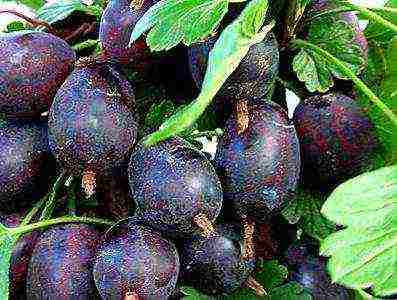 Berries of this species really look like small pears. Fruits are dark purple in color, medium in size, weight 4.3 g. The taste is usually sweet and sour. The variety has high winter hardiness, there are no thorns on it, and it also has good resistance to diseases. The bushes of this variety are slightly spreading and compact. Suitable for breeding in the Moscow region and central Russia. The yield of the bush is at the level of 6 kg, and is not lost for 20 years, with proper care.
Berries of this species really look like small pears. Fruits are dark purple in color, medium in size, weight 4.3 g. The taste is usually sweet and sour. The variety has high winter hardiness, there are no thorns on it, and it also has good resistance to diseases. The bushes of this variety are slightly spreading and compact. Suitable for breeding in the Moscow region and central Russia. The yield of the bush is at the level of 6 kg, and is not lost for 20 years, with proper care.
Description of the variety "Malachite"
 It is very similar to "Grushenka" - it bears fruit well, resists diseases and is winter-hardy. It turned out from crossing the Date and the Black Negus. Fruits of bright green color, usually with a waxy coating, grow abundantly on the bush. This vigorous shrub is suitable for planting and breeding throughout the country; up to 3.8 kg of berries can be harvested per season. Of the shortcomings, perhaps, excessive spreading and spiny.
It is very similar to "Grushenka" - it bears fruit well, resists diseases and is winter-hardy. It turned out from crossing the Date and the Black Negus. Fruits of bright green color, usually with a waxy coating, grow abundantly on the bush. This vigorous shrub is suitable for planting and breeding throughout the country; up to 3.8 kg of berries can be harvested per season. Of the shortcomings, perhaps, excessive spreading and spiny.
Description of the variety "Commander"
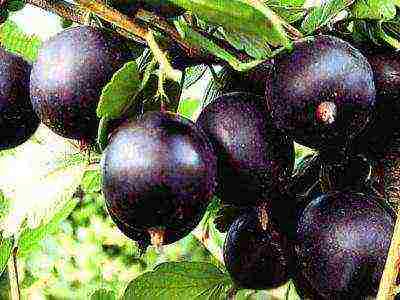 This beautiful species with dark fruits was first introduced from warm Italy. The juicy pulp of dark fruits and the complete absence of thorns - this is why this variety fell in love with our compatriots. From this vigorous and slightly spreading bush, it is possible to collect up to eight kg of fruit. The berries themselves are average, weighing 5-7 g, the yield is high. It is considered the best of the sweet types, while it tolerates cold weather, so it is better to plant in the southern regions. The commander is good at resisting infections.
This beautiful species with dark fruits was first introduced from warm Italy. The juicy pulp of dark fruits and the complete absence of thorns - this is why this variety fell in love with our compatriots. From this vigorous and slightly spreading bush, it is possible to collect up to eight kg of fruit. The berries themselves are average, weighing 5-7 g, the yield is high. It is considered the best of the sweet types, while it tolerates cold weather, so it is better to plant in the southern regions. The commander is good at resisting infections.
Description of the variety "Kolobok"
 Huge fruits are oval, dark red in color, with a sweet and sour taste. The gingerbread man survives the winter perfectly, bears excellent fruit, and at the same time has a high resistance to infections. Suitable for breeding throughout the country, and ripens by mid-summer. Each bush makes it possible to collect up to twelve kg. There are almost no thorns, the bush itself is sprawling and small in size.
Huge fruits are oval, dark red in color, with a sweet and sour taste. The gingerbread man survives the winter perfectly, bears excellent fruit, and at the same time has a high resistance to infections. Suitable for breeding throughout the country, and ripens by mid-summer. Each bush makes it possible to collect up to twelve kg. There are almost no thorns, the bush itself is sprawling and small in size.
Description of the variety "Krasnoslavyansky"
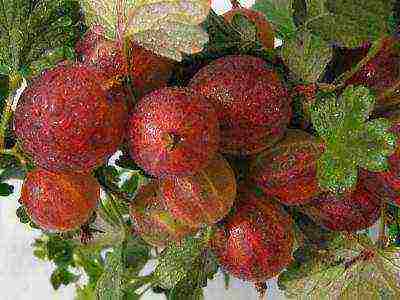 A medium-sized shrub, growing widely, on which fruits are almost perfectly round, dark cherry in color. This large berry with a thin skin hides sweet flesh. This variety is distinguished by its high prickling along the entire length of the shoots. It survives frosts well, while it is resistant to diseases, sometimes it is affected by powdery mildew.
A medium-sized shrub, growing widely, on which fruits are almost perfectly round, dark cherry in color. This large berry with a thin skin hides sweet flesh. This variety is distinguished by its high prickling along the entire length of the shoots. It survives frosts well, while it is resistant to diseases, sometimes it is affected by powdery mildew.
Description of the variety "Amber"
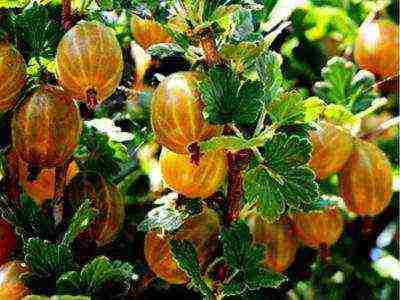 This vigorous, spreading shrub ripens early and bears fruit abundantly. At the same time, there are few thorns, and the berries are large, golden in color, and have a sour-sweet taste. Possesses high resistance to diseases, can be planted throughout the country.
This vigorous, spreading shrub ripens early and bears fruit abundantly. At the same time, there are few thorns, and the berries are large, golden in color, and have a sour-sweet taste. Possesses high resistance to diseases, can be planted throughout the country.
Description of the variety "Honey"
This variety gives one of the sweetest berries, according to the assurances of botanists, the fruits contain up to 17% sugar, which is slightly less than grapes. The fruits are not very large, amber in color, hidden from gardeners under a large number of sharp thorns. Unfortunately, it very weakly resists diseases, although it winters well. For its incredible taste, it requires special planting rules - best of all in a humid place.
Description of the variety "Lada"
 This medium-sized, not spreading bush belongs to the late ripening period. There are few thorns on the shoots, so there will not be much prickling during harvesting. Berries are oval, very large (up to 8 g), taste like dessert. It tolerates wintering very well and resists diseases, it is undemanding to soil and care. Can be planted throughout the country.
This medium-sized, not spreading bush belongs to the late ripening period. There are few thorns on the shoots, so there will not be much prickling during harvesting. Berries are oval, very large (up to 8 g), taste like dessert. It tolerates wintering very well and resists diseases, it is undemanding to soil and care. Can be planted throughout the country.
Description of the variety "Beryl"
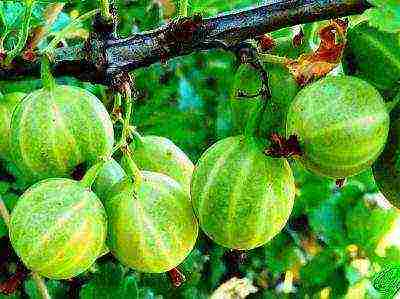 This variety, like the previous one, is famous for its large sweet and sour fruits (berry weight up to 9.2 grams), moreover, it has a tasting score of 5 points. There are few thorns on the shoots, mostly they are all in the lower part. The bush is medium-sized, not spreading with a lush crown.It tolerates wintering perfectly, in the same way it resists diseases, including powdery mildew. However, there is a message that may still be amazed at her. Suitable for planting throughout our country.
This variety, like the previous one, is famous for its large sweet and sour fruits (berry weight up to 9.2 grams), moreover, it has a tasting score of 5 points. There are few thorns on the shoots, mostly they are all in the lower part. The bush is medium-sized, not spreading with a lush crown.It tolerates wintering perfectly, in the same way it resists diseases, including powdery mildew. However, there is a message that may still be amazed at her. Suitable for planting throughout our country.
Description of the variety "Canned"
 The variety is called that way for a reason, because it has a standard sweet and sour taste, but is more valuable for processing. Berries of medium size, bright green. The bush is vigorous, medium spreading, bears fruit quite well, copes with frost and is almost not affected by diseases.
The variety is called that way for a reason, because it has a standard sweet and sour taste, but is more valuable for processing. Berries of medium size, bright green. The bush is vigorous, medium spreading, bears fruit quite well, copes with frost and is almost not affected by diseases.
Description of the "Consul" variety
 The main advantages of this variety are high yield and pleasant berry taste. The number of thorns is small, they are concentrated in the middle of the bush. The variety tolerates wintering well, especially frosts in the spring, and has a high degree of disease resistance. It can be planted throughout the country. The bushes are vigorous, medium spreading, with medium sized berries. Self-fertility in this variety is not bad, but it is better to think about planting around other pollinating varieties.
The main advantages of this variety are high yield and pleasant berry taste. The number of thorns is small, they are concentrated in the middle of the bush. The variety tolerates wintering well, especially frosts in the spring, and has a high degree of disease resistance. It can be planted throughout the country. The bushes are vigorous, medium spreading, with medium sized berries. Self-fertility in this variety is not bad, but it is better to think about planting around other pollinating varieties.
Description of the variety "Invicta"
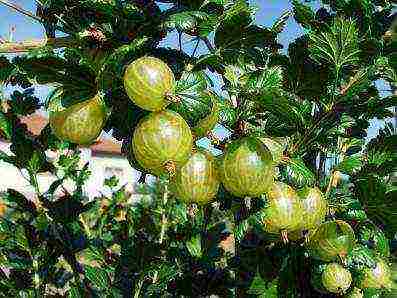 The shoots of this tall, spreading bush are studded with thorns, and the berries are medium in size or smaller. A very productive variety, it has an extremely high winter hardiness, moreover, it is not afraid of powdery mildew. Bred recently in England. The fruit has a yellow or green-yellow color, sweet taste, very well suited for processing. The variety is suitable for mechanical harvesting.
The shoots of this tall, spreading bush are studded with thorns, and the berries are medium in size or smaller. A very productive variety, it has an extremely high winter hardiness, moreover, it is not afraid of powdery mildew. Bred recently in England. The fruit has a yellow or green-yellow color, sweet taste, very well suited for processing. The variety is suitable for mechanical harvesting.
Description of the variety "Russian Yellow"
 This variety was bred for cold growing regions and takes root even better in the southern ones. The appearance is a bit similar to Invicta in the middle ripening period. Fruits are amber in color, differ in that they can be kept fresh for a long time. The taste is sweet with a slight sourness, well suited for processing and production of jellies, preserves and jams. Well tolerates cold and harsh climate, does not succumb to powdery mildew. The bush is medium-sized, spreading with an average stud of shoots.
This variety was bred for cold growing regions and takes root even better in the southern ones. The appearance is a bit similar to Invicta in the middle ripening period. Fruits are amber in color, differ in that they can be kept fresh for a long time. The taste is sweet with a slight sourness, well suited for processing and production of jellies, preserves and jams. Well tolerates cold and harsh climate, does not succumb to powdery mildew. The bush is medium-sized, spreading with an average stud of shoots.
Description of the variety "Emerald"
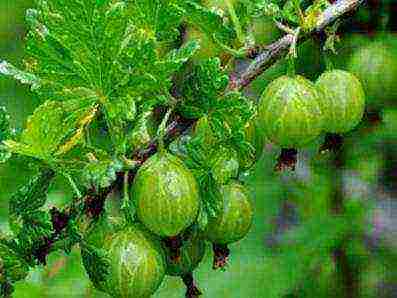 The early ripening variety, not spreading and of medium height, was obtained by crossing the Nugget and the Firstborn. A fairly high degree of prickling, but the shoots give berries, mostly large in size. The berries are green in shape, closer to the oval in shape, and the taste is sweet, deserved a tasting rating of 5. Each bush collects 5-6 kg of berries, which can be used fresh, as well as processed - the fruits are great for preserves, jams and freezing. No disease propensity has been identified - the variety has excellent immunity. The advantages include high yield and good taste, as well as large-fruited.
The early ripening variety, not spreading and of medium height, was obtained by crossing the Nugget and the Firstborn. A fairly high degree of prickling, but the shoots give berries, mostly large in size. The berries are green in shape, closer to the oval in shape, and the taste is sweet, deserved a tasting rating of 5. Each bush collects 5-6 kg of berries, which can be used fresh, as well as processed - the fruits are great for preserves, jams and freezing. No disease propensity has been identified - the variety has excellent immunity. The advantages include high yield and good taste, as well as large-fruited.
Description of the variety "Date"
 It is also called Goliath - and deservedly so, because berries can reach up to 20 g in weight. This is subject to thinning and good fertilization of the bush. It grows in a very lush, tall and spreading bush. The thorniness of the bush is average, they are mainly concentrated in the lower part of the bush. Fertility is excellent, and with proper care and abundant fertilization, it becomes simply enormous - during the period of technical maturity, 13 kg of berries can be easily picked from the bush. There is a peculiarity of fruit ripening - if the bush is already in full botanical maturity, then the collection is carried out in two or three steps, due to the strong spreading of the plant, the fruits in the lower part remain in the shade and lag behind in ripening. The variety can be classified as late ripening - it is worth starting harvesting only in the second half or end of August.
It is also called Goliath - and deservedly so, because berries can reach up to 20 g in weight. This is subject to thinning and good fertilization of the bush. It grows in a very lush, tall and spreading bush. The thorniness of the bush is average, they are mainly concentrated in the lower part of the bush. Fertility is excellent, and with proper care and abundant fertilization, it becomes simply enormous - during the period of technical maturity, 13 kg of berries can be easily picked from the bush. There is a peculiarity of fruit ripening - if the bush is already in full botanical maturity, then the collection is carried out in two or three steps, due to the strong spreading of the plant, the fruits in the lower part remain in the shade and lag behind in ripening. The variety can be classified as late ripening - it is worth starting harvesting only in the second half or end of August.
Description of the variety "Bogatyr"
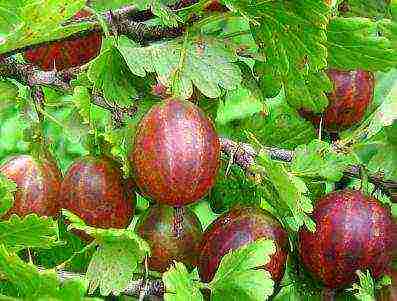 Another representative of the gooseberry with huge fruits, which can also reach up to 20 g, like in the previous variety. 7-8 kg of berries are harvested from each bush. We can say that these varieties have a lot in common, for example, the color of the berries is red-brown. The ripening period is the same - mid-late, they start harvesting not earlier than August. The bush is medium-sized, not spreading and has an average number of thorns.Resistance to disease and cold is high - it can be safely grown in the Siberian region.
Another representative of the gooseberry with huge fruits, which can also reach up to 20 g, like in the previous variety. 7-8 kg of berries are harvested from each bush. We can say that these varieties have a lot in common, for example, the color of the berries is red-brown. The ripening period is the same - mid-late, they start harvesting not earlier than August. The bush is medium-sized, not spreading and has an average number of thorns.Resistance to disease and cold is high - it can be safely grown in the Siberian region.
Description of the "Redball" variety
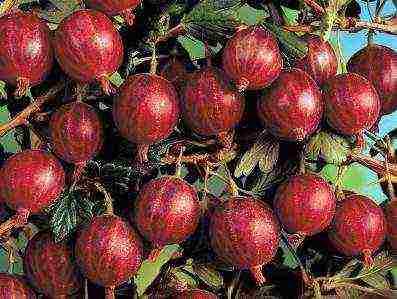 The variety appeared recently and is distinguished by the complete absence of thorns and its early maturity. Unfortunately, this affects the size of the fruits - the average weight is 5 g. The bush is medium-sized, compact, when harvesting, it gives 5-7 kg of fruits. It winters well and is not at all afraid of diseases, including powdery mildew.
The variety appeared recently and is distinguished by the complete absence of thorns and its early maturity. Unfortunately, this affects the size of the fruits - the average weight is 5 g. The bush is medium-sized, compact, when harvesting, it gives 5-7 kg of fruits. It winters well and is not at all afraid of diseases, including powdery mildew.
Description of the variety "Plum"
 A bush of medium early ripening, was obtained by crossing a large number of other gooseberry species (Malachite, English yellow, Date and some others). The variety turned out to be vigorous, but compact, with a neat medium-sized crown. Berries are medium in size, 5-6 grams each, with a pleasant sweet plum flavor. This variety is distinguished by good winter hardiness, and also easily tolerates dry summers. Resistant to all diseases, large-fruited and well-fruiting variety. From each bush, you can collect 5 kg of berries. Among the shortcomings is the strong spine of the shoots.
A bush of medium early ripening, was obtained by crossing a large number of other gooseberry species (Malachite, English yellow, Date and some others). The variety turned out to be vigorous, but compact, with a neat medium-sized crown. Berries are medium in size, 5-6 grams each, with a pleasant sweet plum flavor. This variety is distinguished by good winter hardiness, and also easily tolerates dry summers. Resistant to all diseases, large-fruited and well-fruiting variety. From each bush, you can collect 5 kg of berries. Among the shortcomings is the strong spine of the shoots.
Description of the variety "Grossular"
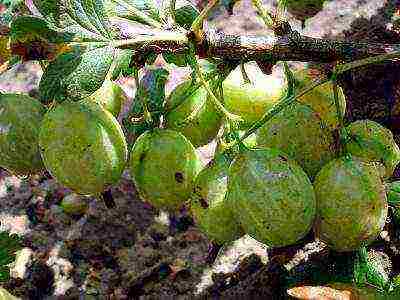 A vigorous, medium-spreading gooseberry variety with few thorns. Berries are large, 5-8 grams each, with a thin skin and sweet and sour taste, are more valued in processed form - jams, preserves, compotes. It tolerates wintering and drought well, while it is almost devoid of thorns, and is not afraid of diseases.
A vigorous, medium-spreading gooseberry variety with few thorns. Berries are large, 5-8 grams each, with a thin skin and sweet and sour taste, are more valued in processed form - jams, preserves, compotes. It tolerates wintering and drought well, while it is almost devoid of thorns, and is not afraid of diseases.
Description of the variety "Belarusian red"
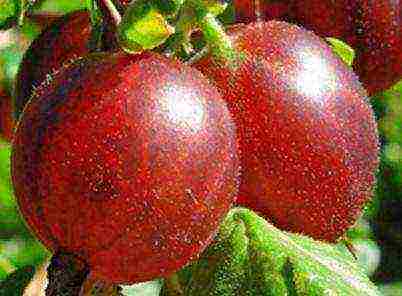 A new gooseberry variety, promising, with medium-sized bushes of medium spreading appearance. A very productive variety, especially when it grows in the sun, up to 7-8 kg of berries are harvested from each bush. The ripening period of the fruits is average, the bush gives a bountiful harvest of berries with a sweet wine taste. The variety is resistant to our winter, as well as to diseases, especially powdery mildew, but sometimes it can be affected by spheroteka. The variety is considered universal, suitable for fresh consumption, and for processing into compotes, jams, as well as wine - this is favored by the taste of berries.
A new gooseberry variety, promising, with medium-sized bushes of medium spreading appearance. A very productive variety, especially when it grows in the sun, up to 7-8 kg of berries are harvested from each bush. The ripening period of the fruits is average, the bush gives a bountiful harvest of berries with a sweet wine taste. The variety is resistant to our winter, as well as to diseases, especially powdery mildew, but sometimes it can be affected by spheroteka. The variety is considered universal, suitable for fresh consumption, and for processing into compotes, jams, as well as wine - this is favored by the taste of berries.
Description of the variety "Green Rain"
 The most frost-resistant gooseberry variety from the entire review, in addition, it is not afraid of drought and diseases. The bush is low, semi-spreading, and, moreover, almost without thorns. The berries are small, cover almost the entire branch, hang tightly, which makes harvesting easier. It tastes honey, with a slight sourness, medium in size - about 7 grams. The variety is characterized as fast-growing and starts producing berries as early as the second year after planting. The fruits are universal - they are used both fresh and processed.
The most frost-resistant gooseberry variety from the entire review, in addition, it is not afraid of drought and diseases. The bush is low, semi-spreading, and, moreover, almost without thorns. The berries are small, cover almost the entire branch, hang tightly, which makes harvesting easier. It tastes honey, with a slight sourness, medium in size - about 7 grams. The variety is characterized as fast-growing and starts producing berries as early as the second year after planting. The fruits are universal - they are used both fresh and processed.
Summarizing
As you can see, from the variety of varieties, the eyes simply run up, it is difficult to stop a choice on any one variety, because you want everything at once! Do not rush to conclusions, carefully weigh everything and think over - after all, the plant is bought for many years, and you will need to strike a balance between practical properties and taste. Choosing a gooseberry, carefully studying the description and finding a suitable variety for yourself, you will make your garden even a little better.
Gooseberry, this thorny shrub is at least one specimen, but it must be found on every garden plot. This culture has a rich history and has been known to man for a very long time. Gooseberry was once grown on a large scale in our country, but most of its plantings were destroyed by powdery mildew brought from another continent. It took years for breeders to be able to develop varieties that are resistant to this ailment, and now the demand for gooseberry planting material and the area under this crop is increasing every year.
Various varieties of gooseberries
At the moment, there are 46 varieties of this wonderful crop in the State Register of Breeding Achievements of the Russian Federation, the very first varieties of gooseberries were obtained back in 1959, these are the varieties: Malachite, Russian, Seianets Lefora, Smena and Chelyabinsk green.New items introduced in the 21st century: White Nights, Defender, Kazachok, Candy, Favorite, Narodny, Spring, Northern Captain, Serenade, Snezhana, Ural Emerald, Ural Pink, Flamingo, Shershnevsky and Eridan.
Each of these gooseberry varieties is recommended for one or several regions of the Russian Federation, selected in accordance with a number of climatic features. There are 12 such regions in total, one or another gooseberry variety is recommended for each of them. Let's take a closer look at the varieties and find out for which of the regions this or that cultivar is recommended.
Let's start with the variety Harlequin, it was received in 1995 and recommended for regions 9 and 10 - Ural and West Siberian... This gooseberry variety is characterized as late, it is a shrub, it is characterized by an average vigor of growth, an average spreading crown and has rather large leaf blades of green color. There are usually three flowers in the inflorescence of this variety. After flowering, the berries are tied, they are red in color, round in shape, with a taste estimated by tasters at 4.4 points out of 5 possible. Fruits contain up to 6.0% sugars, more than 3% acids, over 24 mg% ascorbic acid. The yield per bush reaches 2.5 kg. The variety is not affected by powdery mildew, rarely damaged by the sawfly.
Cultivar White Nights was launched in 2000 and recommended for cultivation in the second, Northwest region... The fruits of the variety ripen early. The plant itself is a very modest bush with straight, thorny shoots. The leaf blades are medium in size and green in color. In the inflorescence there is usually one, less often - two flowers. Gooseberry fruits weighing about 3.5 g, their shape is round, yellow-green in color, there is a slight pubescence. Tasters rate the taste at 4.3 points, the appearance at 4.4 points. Each berry contains up to 10.9% sugars, over 1.8% acids, up to 30 mg% ascorbic acid. The maximum yield per bush is 3.1 kg. The variety is resistant to powdery mildew.
Gooseberry variety Beryl was included in the State Register in 1998 and recommended for growing in regions 9 and 10 - Ural and West Siberian... It is a medium-sized shrub with a slightly spreading crown. Shoots are usually curved, have spines only on the bottom. The leaf blades are rather large. There are two flowers in the inflorescence. The fruits are round, weighing about 3.5 g, yellow-green in color with a skin devoid of pubescence. Tasters rate the taste of berries at 4.4 points, the attractiveness of the appearance - at 4.5 points. Each berry of this variety contains up to 9.8% sugars, about 0.5% acids, more than 38 mg% ascorbic acid. The maximum yield per bush is about six kilograms. The variety is resistant to powdery mildew and has a high winter hardiness.
Gooseberry variety Harlequin Gooseberry variety White nights Gooseberry variety Beryl
Vladil, - this gooseberry variety was obtained in 1995 and recommended for cultivation in 2, 4, 7, 9 and 10 regions, these are the North-West, Volgo-Vyatka, Middle Volga, Ural and West Siberian regions... The harvest of this variety ripens early. Plants of the variety are actively growing shrubs with a slightly spreading crown. The leaf blades are rather large, dark green in color with shine. There may be two or three flowers in the inflorescence. The fruits of the variety reach a mass of 2.9 g, they are red, quite tasty, tasters estimate this indicator at 4.3 points, and the appearance - at 4.4 points. Berries contain up to 15% sugars, more than 2.8% acids, over 28 mg% ascorbic acid. The maximum yield of the variety is about two kilograms per bush. The cultivar is immune to powdery mildew, but can be damaged by the sawfly.
Defender, - this gooseberry variety was obtained relatively recently, in 2010 and recommended for cultivation in the third, Central, region... The variety is characterized by late ripening.Plants of this variety are actively growing shrubs with straight shoots, completely covered with thorns, and large leaf blades of a dark green color. Each inflorescence can have from one to three flowers. The fruits of this species are oval-pear-shaped, dark red, almost black, in color and a noticeable waxy coating. The average weight of the fruit is about 4.9 g. The taste of the berries is quite pleasant, it is rated by tasters at 4.5 points, and the appearance - at 4.6 points. The maximum yield per bush reaches 5.6 kilograms. The variety is drought-resistant, winter-hardy, but can be affected by powdery mildew.
Kazachok, - this gooseberry variety was included in the State Register in 2006 and recommended for growing in the fifth region - Central Black Earth... The ripening period for the variety is medium late. Plants of the variety are shrubs with medium vigor and a spreading crown due to their curved shoots. The leaf blades are bright green in color. In an inflorescence there can be either one or two flowers. The fruits of the variety have a mass of about 3.6 g, they are oval, dark red in color, slightly pubescent. The taste of the berries is quite pleasant, tasters rate it at 4.9 points, which is a very high rating. Each berry of the Kazachok variety contains up to 11.7% sugars, about 1.4% acids, up to 39.8 mg% ascorbic acid. The maximum yield per plant reaches eight kilograms. The variety is resistant to powdery mildew.
Gooseberry variety Vladil
Gingerbread man, - this gooseberry variety was obtained in 1988, it recommended for growing in 3, 4, 5 and 11 regions, that is, in Central, Volgo-Vyatka, Central Black Earth and East Siberian... The variety is characterized by an average ripening period and high yield, reaching six kilograms per bush. The plant of the variety is a medium-sized bush with a rather dense and spreading crown. The thorns on the shoots are small, there are few of them. In inflorescences there can be either one or two flowers. The fruits are very large, can reach a mass of 8.1 g, they are round, dark red. Taste qualities are estimated at 4.6 points. The variety is resistant to powdery mildew.
Candy, - this cultivar was included in the State Register in 2008 and recommended for cultivation in 10 and 11 regions - West Siberian and East Siberian... The variety is characterized by an average ripening period. Plants of the variety are shrubs of medium growth with a compact crown and rather thin shoots. Thorns, like shoots, are thin, located singly and usually only in the lower part of the shoot. In an inflorescence there can be either one or two flowers. Fruits of the variety are medium-sized, spherical, red in color. The gooseberry taste is quite pleasant, it is estimated by the tasters at 4.7 points. The average weight of the fruit is about 3.2 g. Each berry contains up to 8.7% of sugars, more than 1.1% of acids, and more than 55.1 mg of ascorbic acid. The maximum yield of the variety reaches 2.4 kg per bush. The variety is resistant to drought, not afraid of frost.
Cooperator, - gooseberry variety obtained in 1999 and recommended for two regions - 9 and 11, these are the Ural and East Siberian... The crop ripens in the middle late terms. The maximum yield often exceeds six kilograms per bush. Plants of the variety are shrubs of medium height, with a compact, moderately spreading crown. Shoots have thorns only in the lower part, which makes harvesting somewhat easier. There can be two or three flowers in the inflorescence. Fully ripe gooseberry fruits reach a mass of 7.6 g, are pear-shaped and dark red in color, sometimes they look black. The taste is very pleasant, it is considered dessert, its tasters estimate it at 4.9 points. The variety is resistant to powdery mildew.
Gooseberry variety KolobokGooseberry variety CandyGooseberry variety Cooperator
Krasnoslavyansky, - this gooseberry variety was included in the State Register in 1992 and recommended for three regions at once - 2, 3 and 4, these are North-West, Central and Volgo-Vyatka... The harvest of this variety ripens in medium terms, the yield is quite high, reaching seven kilograms per bush. Plants of the variety are small shrubs with a slightly spreading crown. The thorns are small and there are not many of them. The fruits are very large, up to nine grams, their shape is round, the color is dark red, slightly pubescence is noticeable on the surface. The pulp of the berries is very tasty, tasters rated the taste at 4.5 points. The variety is resistant to powdery mildew.
Red large, - it was received in 1974 and recommended for cultivation in the tenth region - West Siberian... Interestingly, this gooseberry variety was obtained from a seedling that accidentally grew, its parents are unknown. The variety is characterized by medium ripening, high winter hardiness and resistance to a complex of diseases and pests. Productivity ranges from three to four kilograms of fruit from a bush over the years. The plants themselves are of medium vigor and rather spreading. There are thorns in abundance on old shoots, on young ones there are very few of them. The berries are not large, reaching a mass of 3.1 g. The shape of the fruit is elongated-oval, the color is dark red. The taste is quite pleasant, it is rated by tasters at 4.5 points.
Kubanets, - this gooseberry variety was bred in 1997 and zoned in only one region - 6, North Caucasian... The harvest on low and slightly spreading bushes of this variety ripens early. It is easy to collect because the thorns on the thick and straight shoots are located only in the lower part. Ripe berries have an oval shape, green color, do not have pubescence and reach a mass of 5.7 g. The maximum yield from a gooseberry bush reaches 9.4 kilograms on good soil. The fruits of the variety are delicious, tasters rate the taste at 4.5 points, and the appearance at 4.6 points. Each berry contains up to 7.7% sugars, about 2.2% acids, over 33 mg% ascorbic acid. The variety is resistant to powdery mildew and does not require pollinating varieties on the site.
Gooseberry cultivar Krasnoslavyansky Gooseberry cultivar Red large Gooseberry cultivar Kubanets
Cultivar Beloved, - it was included in the State Register at the very beginning of the current century - in 2000 and recommended for growing in the 10th region, West Siberian... Berries on the spreading bushes of this gooseberry variety ripen quite early, it is not very convenient to collect them: very thick shoots are covered with no less thick thorns. However, the berries are worth the trouble of picking, they have an oval shape, weigh about 4.0 g, a yellow-green color of dense skin covered with a waxy coating and a rather pleasant taste, albeit without aroma, rated by tasters at 4.9 points. Each fruit contains up to 8.8% sugars, about 2.0% acids, more than 43 mg% ascorbic acid. The yield of the variety is very high and on good soil reaches 8.7 kg per bush. The advantages of the variety include its winter hardiness, resistance to powdery mildew and relative resistance to the sawfly.
Malachite, - an old gooseberry variety, 1959, but it is he who is most often found in summer cottages. The variety is zoned in many regions, it is easier to say in which cultivation is not desirable, these are regions 6, 10 and 11, namely the North Caucasian, West Siberian and East Siberian... The harvest on vigorous and slightly spreading bushes ripens in medium terms. The maximum yield is about four kilograms per bush. The harvest will have to be done with care, because small thorns are scattered over the entire surface of the shoots. However, no one leaves Malachite berries on the shoots, they say that the most delicious jam comes from the fruits of this variety. By the way, the fruits cannot be called small, they reach a mass of 7.1 g, have a slightly elongated shape and a rich green color. The taste is pleasant, the tasters are rated at 4.6 points. The variety is resistant to powdery mildew.
Lighthouse, - this gooseberry variety is newer, it is included in the State Register in 1992 and zoned only in one region - in the North-West (2)... Harvest on well-developed bushes with arched shoots ripens in medium terms. Harvesting is not very easy: the shoots have very sharp thorns, which are sometimes very densely distributed. The mass of berries is not a record - about 3.3 g, the yield is also at an average level - about 5.2 kg per bush. Why is the variety good? Pleasant dark red color of berries, good taste, estimated by tasters at 4.3 points, and high sugar content in them - more than 10.5%. In addition, the variety is characterized by high winter hardiness and resistance to powdery mildew.
Gooseberry variety Lyubimets Gooseberry variety Malachite Gooseberry variety Lighthouse
Gooseberry variety Reliable - included in the State Register in 1994 and recommended for cultivation in three regions at once - West Siberian (10), East Siberian (11) and Far East (12)... The harvest on these winter-hardy bushes with a very compact crown ripens in medium terms. With a fruit weight of 3.1 grams, up to 6.3 kg of fruit can be harvested from a bush. Each berry has an oval shape, pink color and a rather pleasant pulp, although due to the perceived acidity, tasters give the taste only 4.1 points. The fruits contain a lot of sugars, more than 11.8%. The variety is resistant to powdery mildew.
A relatively new variety of gooseberries - People's, it was received in 2009 and zoned in the West Siberian region (10)... The harvest on vigorous bushes of this variety ripens late, which allows to extend the period of consumption of fresh berries. It is quite convenient to pick berries, because there are thorns only at the bottom of the shoots. The mass of the berries is average - about 3.3 points, they are round and dark red in shape. The taste is very pleasant, judged by tasters at 4.9 points, but the yield is not very high, only 3 kg per bush. Of the advantages, we can note resistance to pests and diseases and drought resistance.
Cultivar Rainbow was included in the State Register at the very end of the 20th century, in 1999, he zoned in the West Siberian (10) region... The harvest on medium-sized plants of the variety ripens in medium terms. Picking berries is not so easy, since the thin shoots of the variety are literally dotted with thorns. The berries of this gooseberry variety are not very large, about 2.8 g, but the yield cannot be called low, often it exceeds 6.9 kg per bush. When fully ripe, the fruits of the Raduzhny variety turn into a pleasant, red color, they have an average skin density and a rather pleasant taste, assessed by tasters at 4.9 points. Fruits contain a lot of sugars - more than 8.1% and few acids, less than 1.8%. The variety is only occasionally affected by diseases and damaged by pests.
Gooseberry variety Narodny
The gooseberry variety is considered even newer. Spring, it was received in 2002 and zoned in the Central (3) region... The harvest on medium-sized bushes of this variety ripens early. It is quite easy to pick the berries, since the thick shoots of the variety have thorns only in the lower part. When fully ripe, the berries are yellow-green in color with a slight pink tan on the south side and a rounded oval shape. The weight of the fruits is not bad - just over 5.1 g, but the yield cannot be called a record one, on good soil it reaches 5.8 kg per bush, which, however, is also not bad. There are quite a lot of sugars in the fruits - more than 7.0%, which gives the berries a pleasant taste, it is not for nothing that tasters rate it at 4.9 points. The variety, among other things, is winter-hardy and almost never gets sick.
A rather old variety of gooseberry, which, nevertheless, has not lost its demand, is Pink 2... It was included in the State Register in 1971 and zoned in several regions at once - Central (3) and East Siberian (11)... The harvest on medium-sized bushes of this variety ripens in medium terms. The yield is not very large - about 4 kg per bush, however, the advantages of this variety are that, thanks to the small number of thorns, the berries are easy to pick and they are very tasty due to the large amount of sugar.The mass of berries often reaches 9.8 g, they have a round-oval shape and pinkish-red color. The fruits of this variety are simply excellent in various types of processing, and the plants themselves rarely get sick and are winter-hardy.
Russian, - the gooseberry variety was included in the State Register in 1959, but it is still very popular. The variety is zoned in almost all regions, with the exception of the Ural region (9)... The harvest on vigorous bushes of this variety ripens in medium terms. From a bush, you can collect up to ten kilograms of fruit on good soil, this is a record among gooseberry varieties. The berry weight is also quite good - up to 6.1 g. Each berry is oval and dark red in color. The taste of ripe fruits is quite good, rated by tasters at 4.6 points. Of the positive qualities of the variety, one can note good winter hardiness and resistance to powdery mildew.
Gooseberry cultivar Rodnik Gooseberry cultivar Pink 2 Gooseberry cultivar Russian
Salute, - this gooseberry variety appeared in the State Register in 1994, it is zoned in three regions - North-West (2), Central (3) and Volgo-Vyatka (4)... The harvest on medium-sized bushes of this variety ripens in medium terms. The maximum yield reaches seven kilograms per bush, with a berry weight of 6.7 grams. The palatability of Salut fruit is very high, tasters rate the taste at 4.9 points. The fruits themselves are round-oval in shape and bright pink in color. Of the undoubted advantages of the variety, one can note its high winter hardiness and immunity to powdery mildew.
Gooseberry variety Northern captain, - fairly new, it was included in the State Register in 2007, but zoned only in the North-West (2) region... The harvest on vigorous bushes of this variety ripens in the middle late period. It is quite convenient to collect it because of the almost simultaneous ripening of berries and rather rare thorns. Fully ripe, the berries are round and dark red, almost black. The taste is quite pleasant, thanks to the large amount of sugars (9.1%), it is rated by tasters at 4.5 points. The yield is not very high, only 1.7 kg per bush with a berry weight of 2.5 g. Among the advantages of the variety are winter hardiness and high resistance to pests and diseases.
Cultivar Northerner went on sale in 1991 and immediately gained popularity, especially in those regions where it is zoned - Middle Volga (7) and West Siberian (10)... The crop on medium-sized bushes of this variety ripens late. It is difficult to collect berries, because the thick and straight shoots are completely covered with thorns. The mass of berries in the gooseberry variety is quite large, reaching 8.1 grams, but the yield cannot be called outstanding, it rarely exceeds 3.8 kilograms. Ripe berries have a round-oval shape, yellow-green color and a fairly dense skin. Tasters rate the taste according to the highest score. Of the advantages of the variety, a weak spreading of the bush and high winter hardiness can be noted.
Gooseberry variety Salute Gooseberry variety Northern Captain Gooseberry variety Severyanin
Gooseberry variety Senator was bred in 1995 and zoned in the Volga-Vyatka region (4), Ural (9), West Siberian (10) and Far Eastern (12)... The harvest on vigorous plants of this variety ripens in medium terms. It is quite convenient to collect berries, because there are few thorns. The mass of the berry is not very high, about 3.4 g, which is why the yield cannot be called great; on average, no more than 2.6 kg can be harvested from an adult bush. The shape of the fruit is oval, the color is scarlet-red. Fruits contain up to 6.8% sugars and a lot of ascorbic acid. The berry taste is considered dessert and is rated by the tasters at 4.8 points. From the advantages of the variety, resistance to frost and powdery mildew can be distinguished.
A fairly new variety of gooseberries - Serenade, it was received in 2004 and recommended for cultivation in the Central Black Earth region (5)... The harvest on vigorous and slightly spreading plants of the variety ripens at a later date.With a berry mass of 4.1 g, up to four kilograms of fruit can be harvested from a bush. The berries themselves have an elongated-conical shape and a violet-red color, a skin of medium density and a pleasant taste (4.6 points), which, among other things, provides a high sugar content - up to 10.2%. Of the advantages, first of all, it is worth noting high winter hardiness and drought resistance.
A gooseberry variety with an interesting name - Seedling Lefora was bred in 1959. This variety zoned in many regions - North (1), North-West (2), Volgo-Vyatka (4), Ural (9) and even West Siberian (10)... Now this variety is difficult to get, only true fans of this culture have it. Why is the variety good? It is characterized by high winter hardiness, resistance to powdery mildew and a fairly high yield (about five kilograms per bush) with an average berry weight of only 2.5 grams. By the way, the berries are quite tasty and are rated by tasters at 4.5 points. When fully ripe, they are deep red and have a very pleasant aroma.
Gooseberry variety SerenadeGooseberry variety SenatorGooseberry variety Lefora seedling
Sirius, Is another interesting gooseberry variety obtained in 1994 and zoned in the Central Black Earth (5) region... The harvest from a vigorous shrub can be harvested in medium terms. The yield, by the way, is quite good - up to 7.4 kg per bush with a fruit weight of 3.6 grams. Harvesting is a pleasure because the shoots are devoid of thorns. When fully ripe, the berries are round and dark red in color with a noticeable waxy bloom. The fruit taste is pleasant (4.1-4.3 points). Among the advantages of the variety, one can note its high winter hardiness and resistance to powdery mildew.
Plum, - the variety was obtained in 1986, but until now it is in considerable demand. It is zoned in three regions at once - Central Black Earth (5), Middle Volga (7) and Ural (9)... The positive features of the variety are, of course, its record yield, reaching an almost insurmountable 12 kg per bush on nutrient soil, a rather high weight of fruits - about 6.6 g and their pleasant taste, which tasters estimate at 4.6 points. What are the disadvantages? These are its thorns, they are powerful, they can be double or even triple and occupy the entire surface of the shoots, therefore, it is very difficult to harvest the crop. The gooseberry variety is bought for the sake of berries, so Plum can be safely planted on your site. The berries are large, tasty, dark red, which makes them black from a distance with a very delicate pulp and aroma, like a plum, hence the name. In addition, the variety is drought-resistant and immune to powdery mildew.
A pretty old gooseberry variety Change, entered in the State Register in 1959. This variety is unique primarily in that it zoned in almost all, with the exception of only 6 and 11 regions, that is, the North Caucasian and East Siberian... The crop on medium-sized bushes resistant to powdery mildew is ready for harvest in the middle late periods. Up to six kilograms of fruit can be harvested from one adult bush, given that the mass of one berry usually does not exceed 2.6 g. you can be patient. Of the undoubted positive qualities, first of all, it is worth noting the absence of crop shedding, the absence of the need for regular pruning and treatments against powdery mildew.
Gooseberry variety Sirius Gooseberry variety Smena Gooseberry variety Plum
Snezhana, - this gooseberry variety is quite young, it was included in the State Register in 2009 and is only gaining momentum in popularity. The variety is zoned in the third region - Central... The harvest on medium-sized, compact plants of the variety ripens at a later date. It is quite easy to collect berries, because there are thorns only in the lower part of the shoots.Fruits, when fully ripe, acquire an oval-pear-shaped shape and a yellow-green color. When consumed, acidity is noticeable and a very dense skin is felt, so the tasters rate the variety at only 4.3 points. The yield of the variety is about 4.7 kg per bush with a berry mass of 4.1 g. The main advantage of the variety is its resistance to pests and diseases.
Stanichny, - a variety that has already gained its fans, because it is included in the State Register back in 1995 and zoned in two regions at once - Volgo-Vyatka (4) and Ural (9)... The fruits of this gooseberry variety ripen in medium terms, due to the presence of self-fertility and the large size of the bush, the yield from an adult plant can reach 3.6 kg, with a berry weight of only 2.7 g. By the way, although the fruits are not large, they taste very pleasant , a tasting score of about 4.7 points, they are pink and oval in shape. Each fruit contains up to 9.8% sugars and some acids. The variety is resistant to powdery mildew.
An interesting variety - Ural grapes, it was included in the State Register in 1979 and now it is quite difficult to find seedlings of this variety. The variety is zoned in the seventh region - Srednevolzhsky... This is a table variety of gooseberries, ripening in the early stages and representing a rather tall bush with a spreading crown and medium shoots, entirely covered with thorns. The yield of the variety is low, only 1-1.5 kg per bush with a berry weight of 2.5 g. The fruits have a rounded shape, emerald green color and a rather thin skin. The fruit taste is pleasant (4.3 points). The variety is winter-hardy, resistant to diseases and pests.
Gooseberry cultivar Ural grapes Gooseberry cultivar Snezhana Gooseberry cultivar Stanichny
Newer gooseberry Ural emerald, it is included in the State Register in 2000 (10 - West Siberian and 11 - East Siberian regions)... The variety is distinguished by an early ripening period, medium height and weak crown spreading. The shoots are quite thick and completely covered with thorns. The yield is higher than that of the Ural grapes and is about 5.5 kg per bush due to the fact that the average weight of each berry reaches 4.4 g. The fruits of this variety are green, have interesting white pulp veins and a round-oval shape. Each berry contains up to 9.5% sugars and only 2% acid. Tasters highly rate the taste of the fruit - up to 4.9 points. Of the advantages, it is worth noting high winter hardiness and resistance to a complex of pests and diseases.
An even newer variety - Ural pink, it was included in the State Register in 2004 and zoned in the 10th region - West Siberian... The harvest of this gooseberry variety ripens in medium terms, the plants are weakly growing with practically no spreading crown, the shoots are completely covered with thorns. The yield from an adult plant is about 3.5 kg with a fruit weight of 3.9 g. The berries are very tasty, the tasters give them the highest score, they have a rounded oval shape and pinkish or dark red (berries ripening on the southern side of the bush) coloring. Each berry contains more than 5% sugars. The variety is quite winter-hardy and practically does not get sick.
Flamingo, - this variety is included in the State Register in 2009 and zoned in 10, West Siberian region... The harvest of this gooseberry variety ripens in medium terms, the shoots of a vigorous and rather spreading bush are thin, having thorns over the entire surface. The yield from an adult plant is about 6.3 kg with an average berry weight of about 3.1 g. The fruits of the variety are ovoid, pink, very tasty (4.6 points). Each berry contains more than 9.8% sugars and only 1.1% acids. The variety is winter-hardy, drought-resistant and resistant to pests and diseases.
Gooseberry cultivar Ural pink Gooseberry cultivar Flamingo Gooseberry cultivar Ural emerald
A gooseberry variety, the exact name of which few will repeat by heart - Hinnonmaen Punainen, received in 1999 and zoned in the North and North-West regions... The crop on medium-sized and slightly spreading bushes of this variety with medium-length shoots, completely covered with thorns, ripens at a later date. From one bush, you can collect about 3.5 kg of berries with an average weight of about 2.9 g, oval in shape and dark red color. The taste of the fruit is pleasant (4.3 points), each contains up to 8.5% of sugars and slightly less than 3% of acid. The variety almost does not get sick and is winter hardy.
A very old gooseberry Chelyabinsk green, it was included in the State Register in 1959 and zoned in two regions - Ural and West Siberian... The variety is characterized by a mid-early ripening period and high winter hardiness. In addition, the variety is resistant to powdery mildew and drought, and is also self-fertile. The yield per bush is at the standard level - about 3.5 kg, the weight of the berries is about 2.9 grams. The berries are round-oval, emerald green in color and thin skin. The taste is rated as very good (4.8 points).
Variety Chernomor, well-known and widespread, despite the fact that it was received in 1994. Zoned Chernomor in the Central region, but, in fact, grows well almost everywhere... Ripening period is medium late. The gooseberry variety has high winter hardiness and resistance to various diseases. The yield of the variety is very high - more than 9 kg per bush with a berry weight of 3.1 g. The shape of the berries is round-oval, the color is dark red, and in the berries growing on the southern side of the bush it is almost black. The berry taste is quite good (4.4 points). Berries are ideal for processing.
Gooseberry cultivar Chelyabinsk green Gooseberry cultivar Chernomor
Another very famous and widespread variety of gooseberries is Prune... It was included in the State Register in 1992 and zoned in three regions - Central, Middle Volga and Ural... Everyone who is engaged in the production of homemade wine claims that it turns out from the fruits of this variety much better than from grapes. The variety is characterized by an average ripening period, high winter hardiness and immunity to powdery mildew. The yield of the variety is high - it reaches 8.8 kg per bush with an average berry weight of 4.1 g. It is convenient to collect berries, because there are few thorns on the shoots and they are usually concentrated in their lower part. The shape of the berries is oval, the color is dark red, and on the southern side of the bush, the fruits are even black. The taste is good, it has a specific aftertaste that reminds many of the taste of prunes (4.5 points).
Gooseberry variety Black Cherkashina, - was included in the State Register in 1991 and zoned in the West Siberian and East Siberian regions... The variety is characterized by a medium late ripening period, high winter hardiness and immunity to powdery mildew. The yield of the variety is not very high - about 4.5 kg per bush with an average berry weight of 2.5 g. The harvest is quite convenient, because the thorns are located at the bottom of the shoots. The shape of the berries is pear-shaped, the color is almost black, the taste is medium (4.1 points). The fruits are suitable for all types of processing, but jam turns out to be especially successful.
Shershnevsky, - this gooseberry variety is included in the State Register in 2006 and zoned in four regions at once - the Middle Volga, Ural, West Siberian and East Siberian... The variety is named so unusually because of the thorns on the shoots, they are very long, thick, single or double, but the plus is that they are mostly located at the base of the shoots. The yield of the variety is not very high, no more than 3.2 kg per bush with an average berry weight of 3.5 g. The shape of the berries is round-oval, the color is dark pink with a well-visible matt bloom, there is no pubescence. The taste of the berries is very pleasant and the tasters give them the highest score. The variety is resistant to drought and frost, practically not affected by pests and diseases.
Gooseberry variety Black Cherkashina Gooseberry variety Shershnevsky Gooseberry variety Prune
A fairly new variety of gooseberries Eridanus, - it is included in the State Register in 2009 and zoned in the Volga-Vyatka region... The variety is characterized by vigorous growth and an average ripening period. Shoots on shoots of medium thickness are located over the entire surface. The yield of the variety is about 2.5 kg per bush with an average berry weight of 3.1 g. The shape of the berries is round-oval, the color is red, the taste is pleasant (up to 4.5 points). Berries contain more than 10.5% sugars. The variety is distinguished by high winter hardiness and drought resistance.
Gooseberry variety YubileynyGooseberry variety Eridan
A very old variety of gooseberries - Anniversary, however, to this day, his seedlings are in demand. The jubilee is included in the State Register in 1965 and zoned in the Central Black Earth region... The variety is characterized by an average ripening period, high winter hardiness and resistance to provocative thaws. The yield of the variety reaches 5 kg per bush with an average berry weight of 4.1 g. The shape of the berries is round or oval, the color is deep yellow. The taste is pleasant, thanks to the sweet and juicy pulp (4.5 points). The berries are ideal for processing.
 Each summer resident strives to plant only the best varieties of bush plants on his site, which can give a good and stable harvest. One of the favorite berries for many of our compatriots is the gooseberry, which can be successfully grown throughout the territory of central and southern Russia. Given the high taste properties of the fruit, as well as the large composition of vitamins and minerals, many people want to see it on their site. However, in order to get a good harvest every year, it is important to find out the best varieties of gooseberries, as well as the features of its correct planting and growing.
Each summer resident strives to plant only the best varieties of bush plants on his site, which can give a good and stable harvest. One of the favorite berries for many of our compatriots is the gooseberry, which can be successfully grown throughout the territory of central and southern Russia. Given the high taste properties of the fruit, as well as the large composition of vitamins and minerals, many people want to see it on their site. However, in order to get a good harvest every year, it is important to find out the best varieties of gooseberries, as well as the features of its correct planting and growing.
What to consider when choosing a gooseberry variety?
Today, a huge number of varieties of red gooseberries and amber yellow are presented on the domestic market, each of which has its own characteristics. It is important to consider here that you need to choose a suitable gooseberry variety based on the person's place of residence, depending on the region and region, since each species has its own preferences in terms of climatic and soil conditions, temperature regime. Thus, the best gooseberry varieties for the Moscow region and unique gooseberry varieties in Ukraine will be different, since the natural conditions here differ from each other.
Interesting photos of gooseberry varieties with a description
So, every summer resident quite reasonably seeks to choose a berry shrub that will not only give a good and plentiful harvest, but also have good resistance to plant diseases. Extreme temperature drops, severe frosts, drought and other harmful factors can significantly reduce the immunity of a plant, which can cause its damage by pests. That is why if a person lives in Ryazan, Kostroma, Tula, Tver or another region lying at the same latitude, then the best varieties of gooseberries for the middle lane are best suited here.
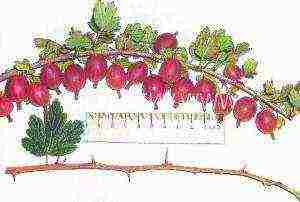 Among the popular and resistant to pest infestation of plants is the gooseberry variety Russian, which has weak branching, a crown of medium density, as well as a strong spreading. The berries of this bush are elliptical in shape, sweet and sour taste.
Among the popular and resistant to pest infestation of plants is the gooseberry variety Russian, which has weak branching, a crown of medium density, as well as a strong spreading. The berries of this bush are elliptical in shape, sweet and sour taste.
This variety tolerates severe winter frosts, as well as summer drought, which makes it the most profitable option for many summer residents.
Correct spring pruning, which consists in cutting out old 5 and 6 year old shoots, gives a good result.
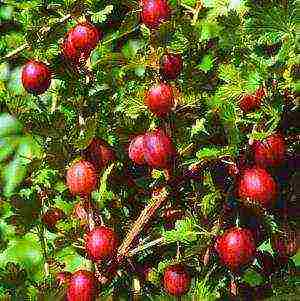 If you need to plant a variety where the number of thorns will be small, you can pay attention to the gooseberry variety Date, which is distinguished by the juicy pulp of the fruit, the dark red type of berries, and a sweet taste.
If you need to plant a variety where the number of thorns will be small, you can pay attention to the gooseberry variety Date, which is distinguished by the juicy pulp of the fruit, the dark red type of berries, and a sweet taste.
The high yield of the bush pleasantly pleases many summer residents, but here you need to take into account the fact that the likelihood of being affected by powdery mildew in wet years increases significantly.
 If you need to get berries of an average ripening period, you can pay attention to the Komandor gooseberry variety, which begins to bear fruit early enough. It is highly resistant to powdery mildew, as well as pests such as sawfly and septoria.
If you need to get berries of an average ripening period, you can pay attention to the Komandor gooseberry variety, which begins to bear fruit early enough. It is highly resistant to powdery mildew, as well as pests such as sawfly and septoria.
Its advantages include the following:
- High yield - 80-155 c / ha;
- Pleasant sweet and sour taste of berries;
- Counteracting major pests;
- Good winter hardiness;
- Few spines.
Large-fruited gooseberry varieties are usually put up for sale, since they are distinguished by their beauty, as well as good transportability, which is very important for many farmers.
The first large varieties of this plant were brought to our country from Europe, namely from Italy, where it was traditionally grown. However, they did not take root especially, since they did not withstand the harsh domestic winters and today they are rarely used.
The following domestic species have gained high popularity among large varieties of gooseberries:
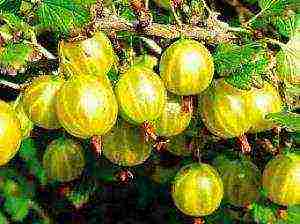 Gooseberry Spring.
Gooseberry Spring.
This variety has large yellow berries with a fairly rich sweet taste. The universal way of using it makes it possible not only to eat it, but also to make jam and cook compotes from it. Gooseberry Jubilee.
Gooseberry Jubilee.
The variety was bred by a selection method, it is characterized by an average winter hardiness, which is why it is most often grown in the southern regions of Russia. The height of the bush can reach 1.5 m, so a trellis binding is very often required here. The berries are distinguished by their high transportability, and therefore they are freely grown not only by summer residents, but also by domestic farmers.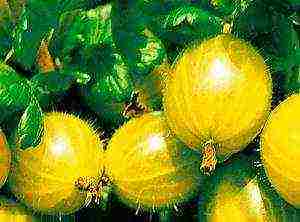 Gooseberry Russian yellow.
Gooseberry Russian yellow.
It tolerates severe winters, has a spreading crown, has sweet and sour yellow berries of medium size. The early ripening period gives this species special popularity among many summer residents. The disadvantages include the low transportability of the plant, so such gooseberries can most often be found on personal household plots, in dachas and vegetable gardens. Gooseberry Senator (Consul).
Gooseberry Senator (Consul).
Differs in high winter hardiness and good yield, as a result of which it is not afraid of spring frosts. The advantages of this gooseberry include good resistance to powdery mildew, as well as the soft and delicate taste of ripe berries. The berries are round, dark red in color, with a delicate skin, sweet and sour taste. The average yield of the variety is 5 kg / bush. This and other varieties of gooseberries for the Leningrad region are very common among summer residents of the Vologda, Novgorod, Pskov and other regions.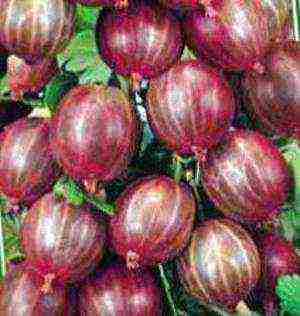 Gooseberry Captivator.
Gooseberry Captivator.
It is a wonderful late-ripening variety bred in the USA. The berries are brown-pink in color, have a rich sweetish-sour taste, and are well suited both for fresh consumption and for seaming.
Popular gooseberry varieties without thorns
The main disadvantage of traditional gooseberry varieties is their thorny bushes, which makes the process of picking berries very difficult and not very pleasant. However, our breeders have managed to develop unique gooseberry varieties that do not contain any thorns at all.
 One of them is the Kolobok gooseberry, the description of the variety of which should begin with berries, which are quite large and weighty. Usually, up to 10 kg of berries can be obtained from one large bush, and healthy and strong, since the variety is quite resistant to powdery mildew and anthracnose.
One of them is the Kolobok gooseberry, the description of the variety of which should begin with berries, which are quite large and weighty. Usually, up to 10 kg of berries can be obtained from one large bush, and healthy and strong, since the variety is quite resistant to powdery mildew and anthracnose.
The berries of this variety have a pleasant sweet and sour taste, have an oval shape and a dark red color. Even if the bush freezes a lot in winter, in the spring it easily recovers after proper pruning.
Other popular varieties of thornless gooseberries include Malachite and Grushenka, which have a pleasant taste and even distribution throughout the bush.In general, their properties are very similar and the difference lies only in the color and shape of the berries, since they are slightly elongated in Grushenka, and in Malachite they are of the correct round shape. For many summer residents, the thornless gooseberry varieties and photos of which can be found on the net are extremely popular.

However, it should be noted that any artificially bred thornless gooseberry, the varieties of which can be purchased in specialized stores, will not have such a rich taste as a regular one with thorns. That is why some summer residents prefer to buy traditional varieties and pick berries carefully.
Features of growing gooseberries in the Urals
Separately, a few words must be said about gooseberries, which are grown in Siberia, the Urals and the Far East. Despite the harsh climate, it is also possible to harvest this berry here, but for this it is necessary to use especially winter-hardy species. Such varieties of gooseberries for Siberia include Beryl, Harlequin, Kazachok, Ural emerald, Cherny Cherkashina and Krasny Vostok.
All varieties of gooseberries for the Urals must be planted correctly, as this will reduce the likelihood of damage to the inner root part in severe frosts. A bump of earth is necessarily poured around the root collar, and for the winter all the stems must be bent to the ground so that they are well covered with snow. This will provide reliable protection against severe frost.
Key findings
Summing up the above, we can say that when choosing a gooseberry variety, the main thing is to be guided by the goals and objectives, since for industrial cultivation, you should choose well-transportable varieties, and for ordinary home use, take with excellent taste. In this case, the climatic features of a particular region must be taken into account.
Gooseberry varieties - video
Gooseberries: how to buy, varieties, care (video)
